– Fat Agnes –
In the free city of Regensburg lived Klara, the daughter of a tinsmith, who was usually called the “Liebfrauenbildlein”; because she was exceedingly beautiful in face and figure. She grew up to be, god-fearing, devote and honourable, as it befits a fine virgin.
One Sunday, when she returned home from the early mass, it happened that a stately nobleman came in her way; he was dressed in velvet and precious finery and wore a heavy gold chain on his chest and a beret with big feathers on his head. And when he saw the lovely maiden, he stopped and looked after her, almost shocked, until she went around the corner. The next Monday, according to her habit, Klara was at mass at St. Cassian’s, and when she stepped out of the church, the nobleman stood there and greeted her. And on Tuesday he greeted her again and suddenly put a little letter into her hand. Hence the virgin blushed deeply and thought she was holding a glowing coal between her fingers. But she did not want to drop the letter in fear of the gossip. Instead she carefully hid it in her scarf, with the intention of throwing it into the fire at home. And if she had done so, she would have been spared great suffering.
But in her small chamber she thought different, because she liked the delicately folded parchment, but especially the gold embroidered ribbon with which it was wrapped. And as she was pondering and turning the little letter back and forth in her hand, suddenly a little voice, like the chirping of a cricket, said to her: “Well, you foolish thing, why do you hesitate so long? Hot off the press! Dead letters don’t bite.” But whoever spoke like this? It was a tiny, barely inch-high woman, crouching in a corner at the fireplace. At first the maiden was horrified by the spook; but because the little one seemed to be untroubled and even acted friendly, she let herself be persuaded and reached for the scissors. And at the moment the tape was cut, the woman grew one finger length higher.
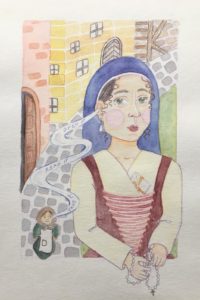
On Wednesday, Klärchen did not go to mass, but locked herself in her chamber as if she were ill. In the meantime, however, she looked for the letter again and read how the nobleman had developed a fierce love for her and could never let go of her and wanted to serve her as an honourable, honest suitor. Such a thing was written in the letter with even fancy words. And while she was still reading, the woman appeared again and cried, “Listen, my daughter! Don’t you hear the sound of spurs in the alley?” And Klärchen hurried to the window and saw the nobleman walking along. He noticed her hiding behind the curtain, because the lovesick have hawk’s eyes. And he greeted up, and she greeted down. But the woman giggled up her sleeve and was growing as high as a shoe, even though it had only been finger-length before.
Thursday, during the meal, the tinsmith scolded his daughter, “You dream in broad daylight and throw more salt into the soup than my palate would like, and the cat steals the meat from the pot before your very eyes.” Towards evening, in the twilight, the woman came back and carried a box of ebony under her arm and said, “Take it. It’s a memento from your suitor.” But Klara stepped back and replied: “Go away, temptress! A virtuous virgin shall not take gifts.”
Then the woman departed grumbling; but at the door she turned around again and said, “A gift is better than a purchase. Think well and see what you despise.” With these words the little woman opened the box, and – o glory! – Inside was a magnificent necklace of vain gold and richly set with pearls and precious stones. The flickering and sparkling enchanted Klärchen and her eyes began to sparkle too. She took the box and stepped in front of the mirror and enjoyed the finery very much. The woman applauded and shouted: “Now you may carry your nose as high as the Countess Monika does.” On Friday they went so far that the nobleman climbed over the garden wall in the darkness and came into the alcove for a little chat. – The little woman was already a cubit high today. – The nobleman talked quite intimately with the tinsmith’s daughter and told her even more beautiful things than he had written in the letter. Meanwhile the woman kept watch at the entrance of the alcove, and – lo and behold! – with every word of love and every handshake it grew an inch in height and an inch in thickness.
And when the couple stepped out of the alcove on Saturday, there stood a superhuman-sized woman with the circumference of a beer barrel. Klara was frightened and screamed, “What are you doing here, you brute?”; But the giantess just laugh loud and replied: “How, my daughter, do you not know your old friend anymore? I am Fat Agnes, and you have kept me well and fed me so much that I, at first a tiny thumb, have grown so tall and fat.”
It is to be known, however, that the fat Agnes was a hellish ghost, which was roaming the city at the time. Initially in the form of a thumb-length woman, it lured people from the right path by those idom and common phrases that guilty pleasure uses to gloss over its actions. And where it was not banned by prayer and devoutness, it stayed like a vampire and sucked itself full and prospered and grew to a ghastly monster.
Klärchen, poor Klärchen: After the nobleman had had his amusement with her for some time, he left her, not bothered by her reproaches and tears, and married the daughter of a rich family. Same things happened to other virgins who had been involved with Agnes, and some of them fell so low that their names were later found in the register of the Reichstag, who, as is well known, was entrusted with the care of the travelling prostitutes.
As far as the menfolk were concerned, the ghost especially seduced young people, who had untold amounts of money in their fingers. It whispered in their ear: “A few pennies will not harm your Lord – he does not feel it. A penny ain’t a silver coin!” Several of these bewitched journeymen started just with a grab into the cash register and ended up as highwaymen.
Such moral corruption made the wise council of Regensburg very much concerned, and they seriously thought about how to master the spook. Physical weapons, however, did not work on him, and so the venerable Minorite Monks were approached for aiding and abetting. According to the legend, they did not easily banish the ghost into the deep cellar of a desolate house at Bäckenspreng. It could still be heard whimpering and groaning for many years afterwards, to the horror of everyone passing by, in the time between the sounds of prayer and the crow of the rooster.



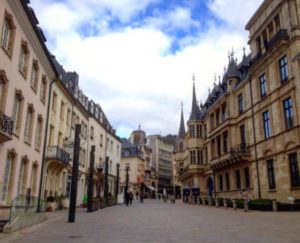
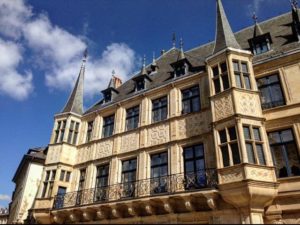 On our way to the Bock plateau, Gilles drew my attention to small Melusina details that are spread all over the old town like the sandstone panel with a depiction of a mermaid under the balcony of the Palais Grand-Ducal. At the Brock plateau we talked more about Luxembourg’s history and Gilles showed me the spot where Melusina allegedly sat when Sigmund first laid eyes on her. You can read all about the famous legend of Luxembourg if you scroll down. After lunch i met up with Robert Philippart. In his position as a UNESCO site manager for town and fortress of Luxembourg we talked a lot about the organisation and discussed different viewpoints people have on World Heritage. Before sundown i visited the Kasematten, a network of caverns underneath the city which are part of the fortress.
On our way to the Bock plateau, Gilles drew my attention to small Melusina details that are spread all over the old town like the sandstone panel with a depiction of a mermaid under the balcony of the Palais Grand-Ducal. At the Brock plateau we talked more about Luxembourg’s history and Gilles showed me the spot where Melusina allegedly sat when Sigmund first laid eyes on her. You can read all about the famous legend of Luxembourg if you scroll down. After lunch i met up with Robert Philippart. In his position as a UNESCO site manager for town and fortress of Luxembourg we talked a lot about the organisation and discussed different viewpoints people have on World Heritage. Before sundown i visited the Kasematten, a network of caverns underneath the city which are part of the fortress. I also tried out the Unesco bike tour and was pleasantly surprised. On my bike tour i really enjoyed spectacular view from the special bike bridge that is located directly underneath the Grand Duke Adolf bridge. It was the perfect way to discover Luxembourg as a whole and not only the city center. Where Brussels is a constant mix, Luxembourg is like all typical city types combined in to one. But because of its special topography it does not not feel thrown together and overwhelming. All quarters are bit segregated by the hills and plateaus Luxembourg is built on. The charming old town, the modern business quarter, the quite suburbs, the beautiful green Petrustal. All could be their own complete town, but together they form a perfect city.
I also tried out the Unesco bike tour and was pleasantly surprised. On my bike tour i really enjoyed spectacular view from the special bike bridge that is located directly underneath the Grand Duke Adolf bridge. It was the perfect way to discover Luxembourg as a whole and not only the city center. Where Brussels is a constant mix, Luxembourg is like all typical city types combined in to one. But because of its special topography it does not not feel thrown together and overwhelming. All quarters are bit segregated by the hills and plateaus Luxembourg is built on. The charming old town, the modern business quarter, the quite suburbs, the beautiful green Petrustal. All could be their own complete town, but together they form a perfect city.
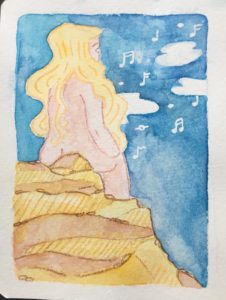 Many hundreds of years ago a noble knight, Count Siegfried, lived at Körich Castle. Once he lost his way while hunting, and toward evening he found himself in a narrow, deep, and wildly overgrown valley. This was the Valley of the Alzette at the place where today the suburbs of Luxembourg City picturesquely blend with the cliffs. Rising before him, the count could see sheer rock cliffs, upon which stood the ruins of an ancient Roman castle. Suddenly the sounds of wonderful singing fell upon the startled knight’s ears. After listening for a time, the count hurried in the direction that the sounds were coming from, and soon he discovered a maiden sitting among the castle’s ruins. Captivated by her beauty, he stood still. It was Melusina, the Nixie of the Alzette. With a fixed gaze Siegfried stared at the otherworldly vision. Seeing the handsome knight, the maiden covered her face with her green veil, then disappeared with the last rays of the evening sun. Overcome with fatigue, Count Siegfried lay down beneath a tree and fell asleep. The next morning the song of a bird awoke him from a blissful dream. He got up and followed the river. He soon found himself in the familiar vicinity of Weimerskirch, and from there he returned straight away to his homeland.
Many hundreds of years ago a noble knight, Count Siegfried, lived at Körich Castle. Once he lost his way while hunting, and toward evening he found himself in a narrow, deep, and wildly overgrown valley. This was the Valley of the Alzette at the place where today the suburbs of Luxembourg City picturesquely blend with the cliffs. Rising before him, the count could see sheer rock cliffs, upon which stood the ruins of an ancient Roman castle. Suddenly the sounds of wonderful singing fell upon the startled knight’s ears. After listening for a time, the count hurried in the direction that the sounds were coming from, and soon he discovered a maiden sitting among the castle’s ruins. Captivated by her beauty, he stood still. It was Melusina, the Nixie of the Alzette. With a fixed gaze Siegfried stared at the otherworldly vision. Seeing the handsome knight, the maiden covered her face with her green veil, then disappeared with the last rays of the evening sun. Overcome with fatigue, Count Siegfried lay down beneath a tree and fell asleep. The next morning the song of a bird awoke him from a blissful dream. He got up and followed the river. He soon found himself in the familiar vicinity of Weimerskirch, and from there he returned straight away to his homeland.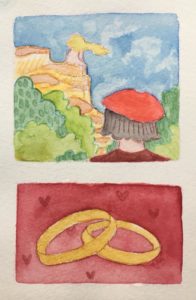 The vision of the beautiful maiden and her wonderful singing had mightily captivated the count’s soul. He often returned to the place, now very dear to him, in order to see her and hear her again. Once he met her in the valley, for she took pleasure in the count’s visits, and she had fallen in love with the handsome knight. He rushed toward her, declared his love for her, and asked her to become his wife. She consented under the condition that she not be required to leave the cliffs, and that he would never ask to see her on Saturdays, when she wished to be alone. Under oath the count promised this to her.
The vision of the beautiful maiden and her wonderful singing had mightily captivated the count’s soul. He often returned to the place, now very dear to him, in order to see her and hear her again. Once he met her in the valley, for she took pleasure in the count’s visits, and she had fallen in love with the handsome knight. He rushed toward her, declared his love for her, and asked her to become his wife. She consented under the condition that she not be required to leave the cliffs, and that he would never ask to see her on Saturdays, when she wished to be alone. Under oath the count promised this to her.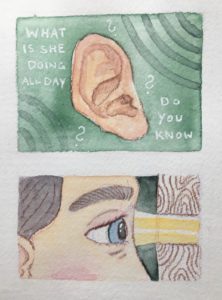 Siegfried entered into an agreement with the Abbot of St. Maximin near Trier to trade the former’s fruitful commune of Feulen near Ettelbruck for the latter’s infertile rocky cliffs and their surrounding woodlands. Because it would have taken years of time and great expense to build a castle on the rocky cliffs, where he could take Melusina home as his wife, Siegfried gladly accepted the help of Satan, who offered to build the castle for him and make him exceedingly wealthy if the count would surrender himself after thirty years. At the top of the cliffs a magnificent castle appeared overnight, proudly looking down on the valley below.
Siegfried entered into an agreement with the Abbot of St. Maximin near Trier to trade the former’s fruitful commune of Feulen near Ettelbruck for the latter’s infertile rocky cliffs and their surrounding woodlands. Because it would have taken years of time and great expense to build a castle on the rocky cliffs, where he could take Melusina home as his wife, Siegfried gladly accepted the help of Satan, who offered to build the castle for him and make him exceedingly wealthy if the count would surrender himself after thirty years. At the top of the cliffs a magnificent castle appeared overnight, proudly looking down on the valley below.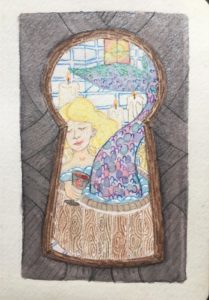 any price, Siegfried wanted to know why Melusina withdrew from him every Saturday. The next Saturday he secretly approached her room. From inside he could hear the sound of rushing and splashing water. Looking into the room through the keyhole he saw his wife in her bathtub combing her long blond hair with a golden comb. Her beautiful limbs ended with a horrible fishtail, with which she was splashing waves. The count uttered a cry of horror, and in the same moment Melusina sank into the depths of the cliffs. Siegfried had lost her forever.
any price, Siegfried wanted to know why Melusina withdrew from him every Saturday. The next Saturday he secretly approached her room. From inside he could hear the sound of rushing and splashing water. Looking into the room through the keyhole he saw his wife in her bathtub combing her long blond hair with a golden comb. Her beautiful limbs ended with a horrible fishtail, with which she was splashing waves. The count uttered a cry of horror, and in the same moment Melusina sank into the depths of the cliffs. Siegfried had lost her forever.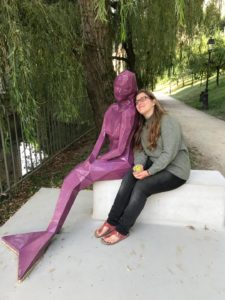 Those stories are the reason why, when Luxembourg was still a fortress, sentry duty, especially at night, was not very popular. One time a courageous soldier who had traded shifts with a comrade was standing guard on the cliff-top. Melusina appeared to him in the form of a beautiful maiden and asked him to redeem her. She told him that it would be a difficult, but not impossible, task. However, he should not attempt it if he thought that he might not succeed, because if he failed she would sink three times deeper into the earth. While she was thus speaking there arose a mighty rumbling sound around the cliffs, causing the soldier to fear that they were about to collapse.
Those stories are the reason why, when Luxembourg was still a fortress, sentry duty, especially at night, was not very popular. One time a courageous soldier who had traded shifts with a comrade was standing guard on the cliff-top. Melusina appeared to him in the form of a beautiful maiden and asked him to redeem her. She told him that it would be a difficult, but not impossible, task. However, he should not attempt it if he thought that he might not succeed, because if he failed she would sink three times deeper into the earth. While she was thus speaking there arose a mighty rumbling sound around the cliffs, causing the soldier to fear that they were about to collapse.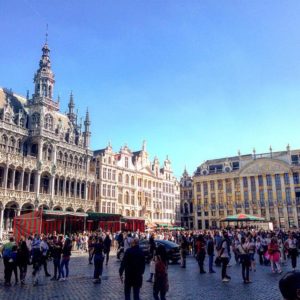 On my way to Luxembourg spontaneously stopped in Brussels for a short stop. The capital of Belgium was a bit of a shock for me. Never have i ever traveled for so long alone and after staying in Bruges, Lille, Brest, Nantes and La Rochelle, i think i was used to small and/or quite cities. Even the bigger cities like Budapest and Bordeaux could not compare to this city. The feeling was totally different. I stayed in a youth hostel in the turkish quarter. I visited all the big places i could fit into my small time frame: Grand Place, Royal Palace, Bourse, Art Nouveau Quarter, the Atom, the Cathedral and the Mont des Arts.
On my way to Luxembourg spontaneously stopped in Brussels for a short stop. The capital of Belgium was a bit of a shock for me. Never have i ever traveled for so long alone and after staying in Bruges, Lille, Brest, Nantes and La Rochelle, i think i was used to small and/or quite cities. Even the bigger cities like Budapest and Bordeaux could not compare to this city. The feeling was totally different. I stayed in a youth hostel in the turkish quarter. I visited all the big places i could fit into my small time frame: Grand Place, Royal Palace, Bourse, Art Nouveau Quarter, the Atom, the Cathedral and the Mont des Arts.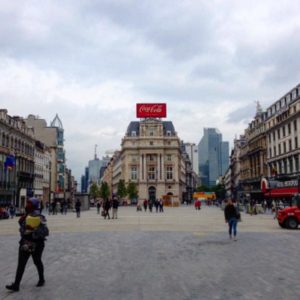 If New York is the city that never sleeps, than Brussels for me is the city that never passes up the chance to celebrate something. In the one and an half days i stayed there they had a free comic festival, a free electronic music festival, a beer fest, a stage at the Grand Place with traditional music and many markets like a flee market and a turkish market. Tom, a local, told me himself that Brussels can be overwhelming, weird and confusing at
If New York is the city that never sleeps, than Brussels for me is the city that never passes up the chance to celebrate something. In the one and an half days i stayed there they had a free comic festival, a free electronic music festival, a beer fest, a stage at the Grand Place with traditional music and many markets like a flee market and a turkish market. Tom, a local, told me himself that Brussels can be overwhelming, weird and confusing at 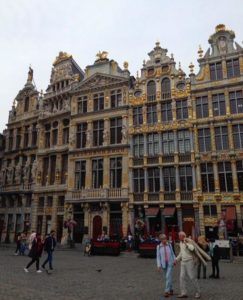 first and that is the way i felt half of the time i stayed there. The wild mix of architecture, from decorative, golden guild houses to big, glass office buildings in the next street. But i also learned to love the people in and their mentality. Tom told me a lot of funny but untrue tales and the special ways the people of Brussels dealt with problems. For example they just covered the river Zenne in the late 19th century with earth instead of cleaning it up. It had become a health hazard because everybody used it as their trash can.
first and that is the way i felt half of the time i stayed there. The wild mix of architecture, from decorative, golden guild houses to big, glass office buildings in the next street. But i also learned to love the people in and their mentality. Tom told me a lot of funny but untrue tales and the special ways the people of Brussels dealt with problems. For example they just covered the river Zenne in the late 19th century with earth instead of cleaning it up. It had become a health hazard because everybody used it as their trash can.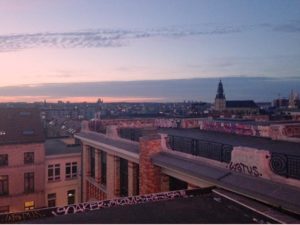
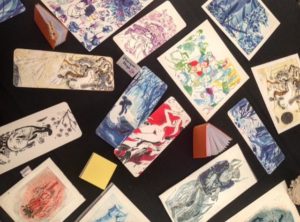
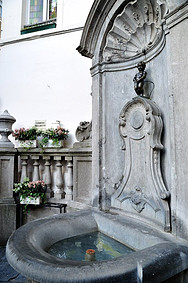 There are more than one origin story of the Manneken Pis statue. The most common one, at least of that i know, is about a little peasant boy. The little boy wandered around out side the city gates as he heard enemies forces approaching and he hid. He saw how they buried dynamite underneath the gates to blow up the city gates and walls. He did not quite understand all the enemies whispered to each other but he knew it was not something good. The boy did’t not know what to do. There was no time to get a adult or warn someone so he got to the end of the fuse and urinated on it. And so a little peasant boy put out the dynamite and saved Brussels.
There are more than one origin story of the Manneken Pis statue. The most common one, at least of that i know, is about a little peasant boy. The little boy wandered around out side the city gates as he heard enemies forces approaching and he hid. He saw how they buried dynamite underneath the gates to blow up the city gates and walls. He did not quite understand all the enemies whispered to each other but he knew it was not something good. The boy did’t not know what to do. There was no time to get a adult or warn someone so he got to the end of the fuse and urinated on it. And so a little peasant boy put out the dynamite and saved Brussels.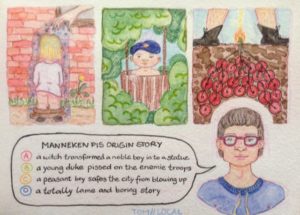 Other stories take about the little Duke Godfrey III of Leuven, a two-year old that was hung in a basket from a tree to bring the troops luck during a battle in Ransbeke. From high up he urinated on the enemies and they lost the battle. Another legend speaks of the son of a noble man, who left a procession to urinate on the wall of a witch’s house. Furiously the witch transformed him into the statue.
Other stories take about the little Duke Godfrey III of Leuven, a two-year old that was hung in a basket from a tree to bring the troops luck during a battle in Ransbeke. From high up he urinated on the enemies and they lost the battle. Another legend speaks of the son of a noble man, who left a procession to urinate on the wall of a witch’s house. Furiously the witch transformed him into the statue.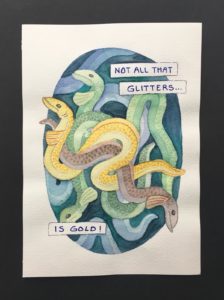
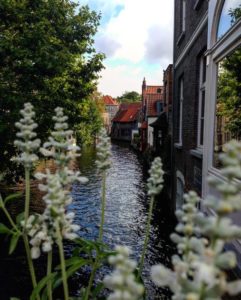 Till this day it is rumoured that you can see at night in the moonlight, a shining golden hand, in which a golden eel twists, rising from the water at where the fisherman vanished. It is as if the devil himself wants to warn the fishermen to stop fishing for eels. Luckily this is not possible, since that day all eels disappeared from the “Reien” (the canals running trough the city) and they never returned.
Till this day it is rumoured that you can see at night in the moonlight, a shining golden hand, in which a golden eel twists, rising from the water at where the fisherman vanished. It is as if the devil himself wants to warn the fishermen to stop fishing for eels. Luckily this is not possible, since that day all eels disappeared from the “Reien” (the canals running trough the city) and they never returned.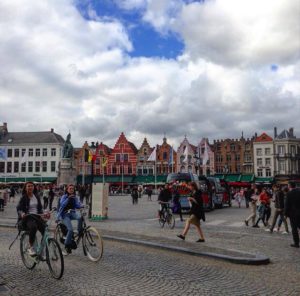 Bruges is a beautiful city. The old town really looks like a postcard. But because of the exceptional big amount of preserved historic buildings, it’s very attractive for tourists. And too many of them are coming to Bruges. Since 2016 the visitor numbers have risen almost a million per year. In 2018 there were 8.3 million visitors compared to 20000 residents in the Unesco protected city center. Because of the rising numbers Buges doesn’t even promote itself anymore. From the 8.3 million visitors 6 million are day trippers, meaning that they don’t stay overnight. They spend only half of the money that regular tourists spend on their trip. Were other cities are campaigning for more visitors to bring revenue to the tourist sector, Bruges is drowning in them. But sadly it’s not the right kind of tourists.
Bruges is a beautiful city. The old town really looks like a postcard. But because of the exceptional big amount of preserved historic buildings, it’s very attractive for tourists. And too many of them are coming to Bruges. Since 2016 the visitor numbers have risen almost a million per year. In 2018 there were 8.3 million visitors compared to 20000 residents in the Unesco protected city center. Because of the rising numbers Buges doesn’t even promote itself anymore. From the 8.3 million visitors 6 million are day trippers, meaning that they don’t stay overnight. They spend only half of the money that regular tourists spend on their trip. Were other cities are campaigning for more visitors to bring revenue to the tourist sector, Bruges is drowning in them. But sadly it’s not the right kind of tourists.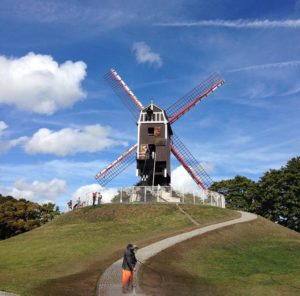 One day doesn’t do Bruges justice. Outside the busy old town i found many gems. I went to the Volkskundemuseum “De zwarte Kat” (The black cat) and lost myself in the oldtimey rooms. I especially liked the pharmacy, the full functioning confectionery and folkloric games. Speaking of cats Bruges has also a cat cafe called Puss and Books, were you also can adopt cats. Near the cafe you can find a neighborhood guerrilla gardening project.
One day doesn’t do Bruges justice. Outside the busy old town i found many gems. I went to the Volkskundemuseum “De zwarte Kat” (The black cat) and lost myself in the oldtimey rooms. I especially liked the pharmacy, the full functioning confectionery and folkloric games. Speaking of cats Bruges has also a cat cafe called Puss and Books, were you also can adopt cats. Near the cafe you can find a neighborhood guerrilla gardening project.  My real highlight was kind of a suprise find. The Heilige Magdalenakerk church behind the Konigin Astridpark. The YOT hosts exhibitions, plays and concerts there. But even without a event the transformed church is worth a visit. I relaxed on the big swing that hangs from the painted high ceiling and enjoyed the original glass windows.
My real highlight was kind of a suprise find. The Heilige Magdalenakerk church behind the Konigin Astridpark. The YOT hosts exhibitions, plays and concerts there. But even without a event the transformed church is worth a visit. I relaxed on the big swing that hangs from the painted high ceiling and enjoyed the original glass windows.  In Bruges I met up with Minou Esquenet and Leentje Gunst in Bruges to talk about the World Heritage, tourism and how both affect the city and it’s locals. Because I had the chance to talk to a city official in Bordeaux too, i now could ask question to compare World Heritage Citys from an other standpoint. On of the my questions was about ecotourism because it was so clear to me that Bruges is swamped by tourists. We also talked about the brand new four-leafed clover plan, which is a concept to chance tourism and it’s effects on Bruges. There are four pillars to ensure the plan works: the balanced, connected, attractive and enterprising city.
In Bruges I met up with Minou Esquenet and Leentje Gunst in Bruges to talk about the World Heritage, tourism and how both affect the city and it’s locals. Because I had the chance to talk to a city official in Bordeaux too, i now could ask question to compare World Heritage Citys from an other standpoint. On of the my questions was about ecotourism because it was so clear to me that Bruges is swamped by tourists. We also talked about the brand new four-leafed clover plan, which is a concept to chance tourism and it’s effects on Bruges. There are four pillars to ensure the plan works: the balanced, connected, attractive and enterprising city.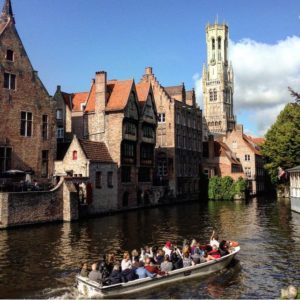 By 2024 the city wants tourists that stay longer, have more sustainable and accessible tourism and locals that love to live in the city and don’t feel stressed by the tourists. Even though most of the locals support tourism and for some their income depends on it, one third sees the rising numbers as a threat to livability and one fourth thinks tourists are causing everyday inconvenience.
By 2024 the city wants tourists that stay longer, have more sustainable and accessible tourism and locals that love to live in the city and don’t feel stressed by the tourists. Even though most of the locals support tourism and for some their income depends on it, one third sees the rising numbers as a threat to livability and one fourth thinks tourists are causing everyday inconvenience.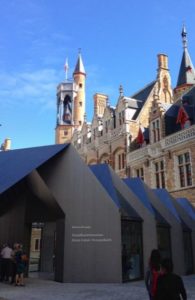 I also had the chance to visit the new Gruuthusemuseum and talk to Leentje, a city architect, about the architecture of Bruges. Everybody talks about the new pavilion you see in the picture right here. It was built on to the estate as a information and ticket center. Compared to the surrounding buildings the pavilion looks quite abstract and new. The sharp roofs are inspired by the classic Bruges house. Many locals protest that the pavilion does not fit in and want it removed. It is important to keep in mind that Unesco does not only stand for preserving, we can and should change things , else we have no world heritage to give and future generation will live in a museum. Bruges city center is so well preserved and so it seems that for some locals this little pavilion is to much change.
I also had the chance to visit the new Gruuthusemuseum and talk to Leentje, a city architect, about the architecture of Bruges. Everybody talks about the new pavilion you see in the picture right here. It was built on to the estate as a information and ticket center. Compared to the surrounding buildings the pavilion looks quite abstract and new. The sharp roofs are inspired by the classic Bruges house. Many locals protest that the pavilion does not fit in and want it removed. It is important to keep in mind that Unesco does not only stand for preserving, we can and should change things , else we have no world heritage to give and future generation will live in a museum. Bruges city center is so well preserved and so it seems that for some locals this little pavilion is to much change.

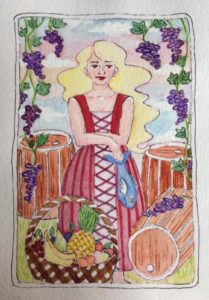
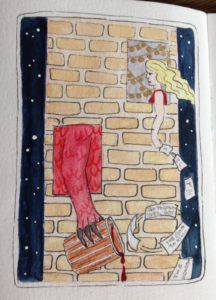 window when the dragon wasn’t looking. Of course the people found the clues and searched everywhere for the staff but the weapon was nowhere to be found in Bordeaux.
window when the dragon wasn’t looking. Of course the people found the clues and searched everywhere for the staff but the weapon was nowhere to be found in Bordeaux. 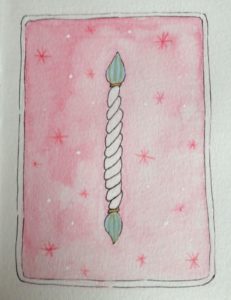 The name of the girl allegedly was Nicolette. She was very pretty, very intelligent and a ploughman’s daughter. The dragon told her he could only be forced to leave the tower by presenting him with the miraculous stick of Saint Martial, a pastoral staff endowed with miraculous powers, which Pope Saint Peter had given to Martial a long time ago before sending him to convert Aquitaine to Christianity. The staff had been in the Limoges Cathedral for years. Twelve jurats from Bordeaux were sent to Limoges to negotiate the loan of the famous staff, six were held hostage to guarantee the loan and the staff of Saint Martial finally
The name of the girl allegedly was Nicolette. She was very pretty, very intelligent and a ploughman’s daughter. The dragon told her he could only be forced to leave the tower by presenting him with the miraculous stick of Saint Martial, a pastoral staff endowed with miraculous powers, which Pope Saint Peter had given to Martial a long time ago before sending him to convert Aquitaine to Christianity. The staff had been in the Limoges Cathedral for years. Twelve jurats from Bordeaux were sent to Limoges to negotiate the loan of the famous staff, six were held hostage to guarantee the loan and the staff of Saint Martial finally 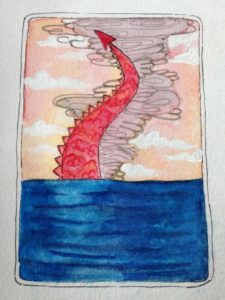 arrived in Bordeaux.
arrived in Bordeaux.  Bordeaux – the Port of the Moon always has be
Bordeaux – the Port of the Moon always has be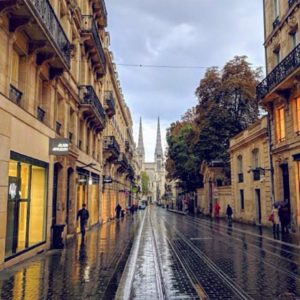
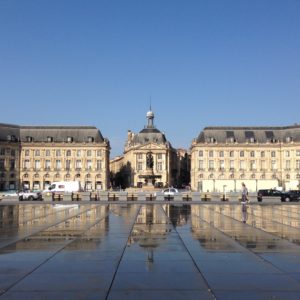
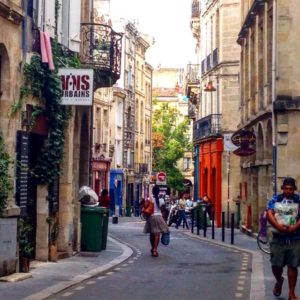 ul as it is. The world heritage of Bordeaux includes many 18th houses and shops, which are in use every day. That’s why the regulations for the old town are very strict: f.e. the doors should always be painted in classic
ul as it is. The world heritage of Bordeaux includes many 18th houses and shops, which are in use every day. That’s why the regulations for the old town are very strict: f.e. the doors should always be painted in classic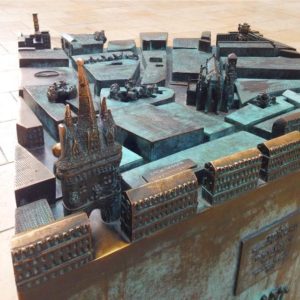
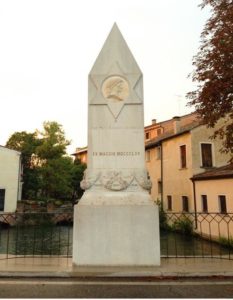
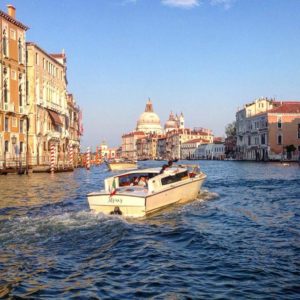 I visited Venice twice before. The first time as a child. I really did not enjoy the city then. Too busy, hot as hell, you can’t move freely and full of street shops and pigeons. Maybe the touristic one day trip with my parents and a bus full of elders wasn`t perfect time to get to know the city either. The second time i went to Venice on a schooltrio. We stayed in Jesolo and visited the 56 Biennial. Even though we ran around around in a big group, it was a different experience. In the evenings after the art exhibitions we wander around with belly’s full of tiramisu and italian vine. Sitting at the water and singing italian songs, well rather butchering them. This time I avoided the busy streets too, went right on a cruse along the shore and visited the Biennial, showing the ever growing evolution of art.
I visited Venice twice before. The first time as a child. I really did not enjoy the city then. Too busy, hot as hell, you can’t move freely and full of street shops and pigeons. Maybe the touristic one day trip with my parents and a bus full of elders wasn`t perfect time to get to know the city either. The second time i went to Venice on a schooltrio. We stayed in Jesolo and visited the 56 Biennial. Even though we ran around around in a big group, it was a different experience. In the evenings after the art exhibitions we wander around with belly’s full of tiramisu and italian vine. Sitting at the water and singing italian songs, well rather butchering them. This time I avoided the busy streets too, went right on a cruse along the shore and visited the Biennial, showing the ever growing evolution of art. 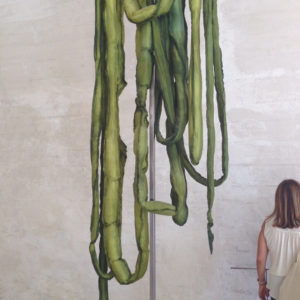
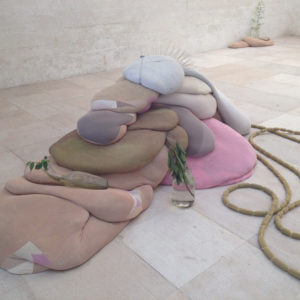
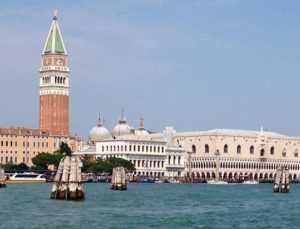
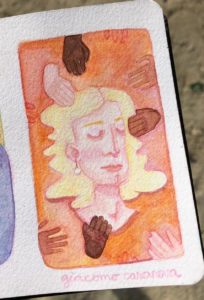 Born 1725 to two actors, Gaetano Casanova and Zanetta Farussi, not only inherited his acting skills but also mother/father complex. Left by his mother at a young age to tour Europe, and his father died. As a child he was treated by a witch for his involuntarily nosebleeds. The “witch” treated him and told him he’d be visited by a beautiful stranger. Later that night, a dazzling woman climbed down the chimney and spoke to him in words he couldn’t understand, and kissed him. In his book L’Histoire de Ma Vie – The Story of My Life he writes that this was the first of many times, a woman’s touch changed the course of his life. His health improved, and in less than a month he learned to read. Casanova said about himself: “I was born for the sex opposite to mine”.
Born 1725 to two actors, Gaetano Casanova and Zanetta Farussi, not only inherited his acting skills but also mother/father complex. Left by his mother at a young age to tour Europe, and his father died. As a child he was treated by a witch for his involuntarily nosebleeds. The “witch” treated him and told him he’d be visited by a beautiful stranger. Later that night, a dazzling woman climbed down the chimney and spoke to him in words he couldn’t understand, and kissed him. In his book L’Histoire de Ma Vie – The Story of My Life he writes that this was the first of many times, a woman’s touch changed the course of his life. His health improved, and in less than a month he learned to read. Casanova said about himself: “I was born for the sex opposite to mine”.